Exploring Mars’s harsh atmosphere
DOI: 10.1063/pt.sjcv.azbb
With its reddish-orange color in the night sky, Mars awakened the curiosity of early astronomers. The ancient Egyptians called the planet Her Desher, meaning “the red one.” Because of the color, ancient civilizations associated the planet with their god of war: the Babylonians called it Nergal; the Greeks, Ares; and the Romans, Mars. After the invention of the telescope in the beginning of the 17th century, the red planet was observed in more detail. Galileo Galilei made the first telescopic observation of the planet in 1610. By 1636 the Italian astronomer Francesco Fontana had made a simplified sketch of the Martian disk.

An upwelling front of dust clouds near the north polar ice cap of Mars, captured by the European Space Agency’s Mars Express in April 2018. The imaged portion of the dust front is about 80 km long. (Courtesy of ESA/DLR/FU Berlin/CC BY-SA 3.0 IGO
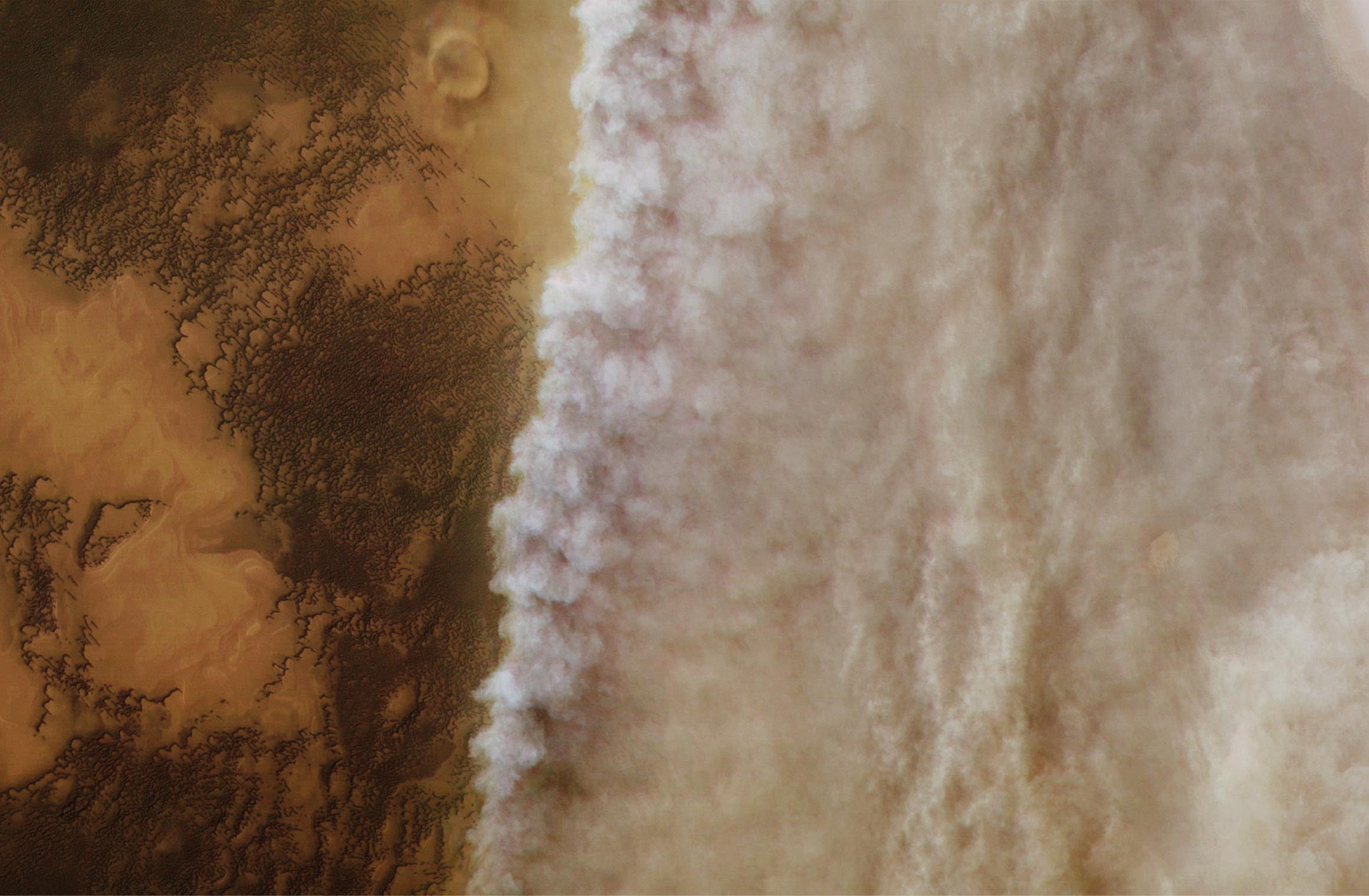
The creation of a detailed surface map of Mars by Giovanni Schiaparelli in 1877 was a crucial step in the planet’s exploration. He termed a series of linear features canali, which was unfortunately mistranslated into English as “canals,” not “channels.” In the late 19th century, that error famously led to speculation that they were artificial waterways built by intelligent aliens. Today we owe our most accurate map of Mars to the Mars Orbiter Laser Altimeter (MOLA), an instrument on the Mars Global Surveyor spacecraft that mapped Mars’s surface from 1997 to 2001.
Figure
Figure 1.

Maps of Mars, old and new. At top is an 1896 map of the Martian surface created by the Italian astronomer Giovanni Schiaparelli on the basis of observations he took in 1883–84. Because 19th-century telescopes produced inverted images, the map is flipped: The southern hemisphere of Mars is at the top. At bottom is the most complete topographic map of Mars available today. Generated in 2000, it is based on four and a half years of measurements taken by the Mars Orbiter Laser Altimeter, an instrument onboard the Mars Global Surveyor. Higher elevations are colored red to white; lower elevations, blue to black. The red planet’s two topographical extremes, Olympus Mons and Hellas Planitia, are marked on the map. (Top image courtesy of Giovanni Schiaparelli/public domain; bottom image adapted from the MOLA Science Team.)
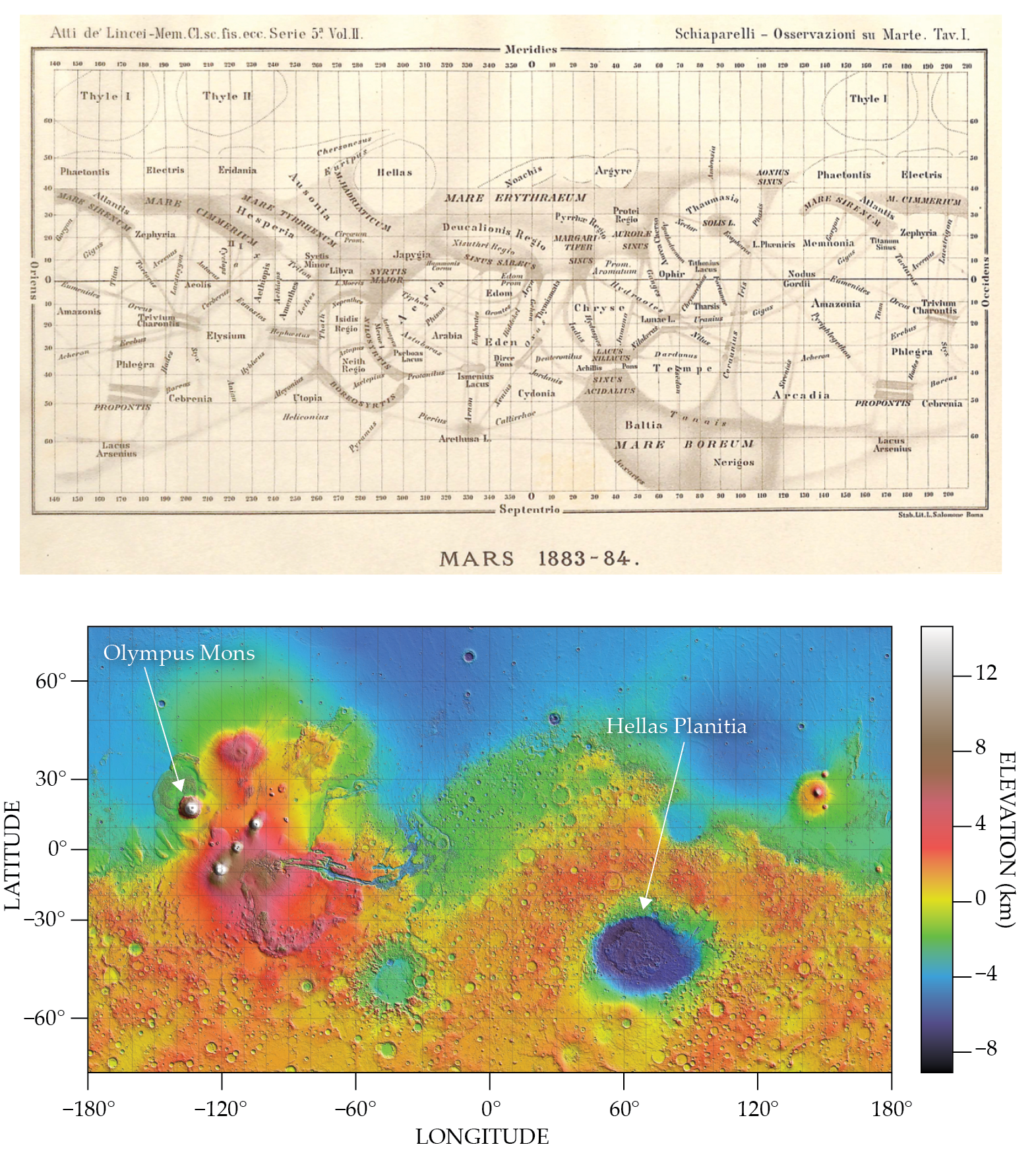
It takes about nine months for a spacecraft to reach Mars. Since the pioneering Mariner 4 flyby in 1965, the red planet has been the destination of numerous orbiters, landers, and rovers. Those missions have studied the planet’s geology, atmosphere, and weather and the question of whether it ever harbored life. Seven orbiters and three rovers are currently exploring the Martian atmosphere and surface. NASA operates two of the rovers, Curiosity and Perseverance, which are situated near the equator. Curiosity’s main goal is to assess whether Mars ever had an environment capable of supporting life; Perseverance’s objectives are to look for signs of ancient life and to collect samples that are intended to be retrieved by a future mission. The other rover, Zhurong, is the first Chinese vehicle on Mars. It was deployed in 2021 by the Tianwen-1 lander.
The rovers are mobile laboratories and observatories: Traveling at approximately 0.1 km/h, they carry multiple instruments, take Martian “biopsies,” and perform remote sensing. The data gathered have revealed much about the red planet’s surface, atmosphere, and ionosphere. They are also informing our understanding of how space weather in the solar system affects Mars. Space agencies are using the results to help prepare for human exploration of Mars in the not-too-distant future.
The Martian atmosphere
With an axial tilt of 25.2°, which is relatively close to Earth’s 23.4°, Mars also has four seasons, but each is about twice as long as Earth’s. Moreover, the seasonal differences are drastic because of Mars’s orbit, which is far more eccentric than Earth’s. The red planet has strong seasonal and interhemispheric differences in atmospheric waves, air circulation, chemical composition, dust distribution and heating, and weather. 1
Mars’s surface and atmosphere are drastically different from Earth’s. The red planet’s surface is mainly covered by fine dust, sand, and rocks and boulders of varying sizes, which are collectively referred to as Martian regolith. Figure
Figure 2.

Two views of the Martian surface. At top is the rim of Jezero Crater, as seen in the first 360° panoramic view taken by NASA’s Perseverance rover in February 2021. At bottom is a mosaic of images taken in 2012 at the Rocknest site by NASA’s Curiosity rover. (Top image courtesy of NASA/JPL-Caltech/Malin Space Science Systems/ASU; bottom image, NASA/JPL-Caltech/Malin Space Science Systems.)
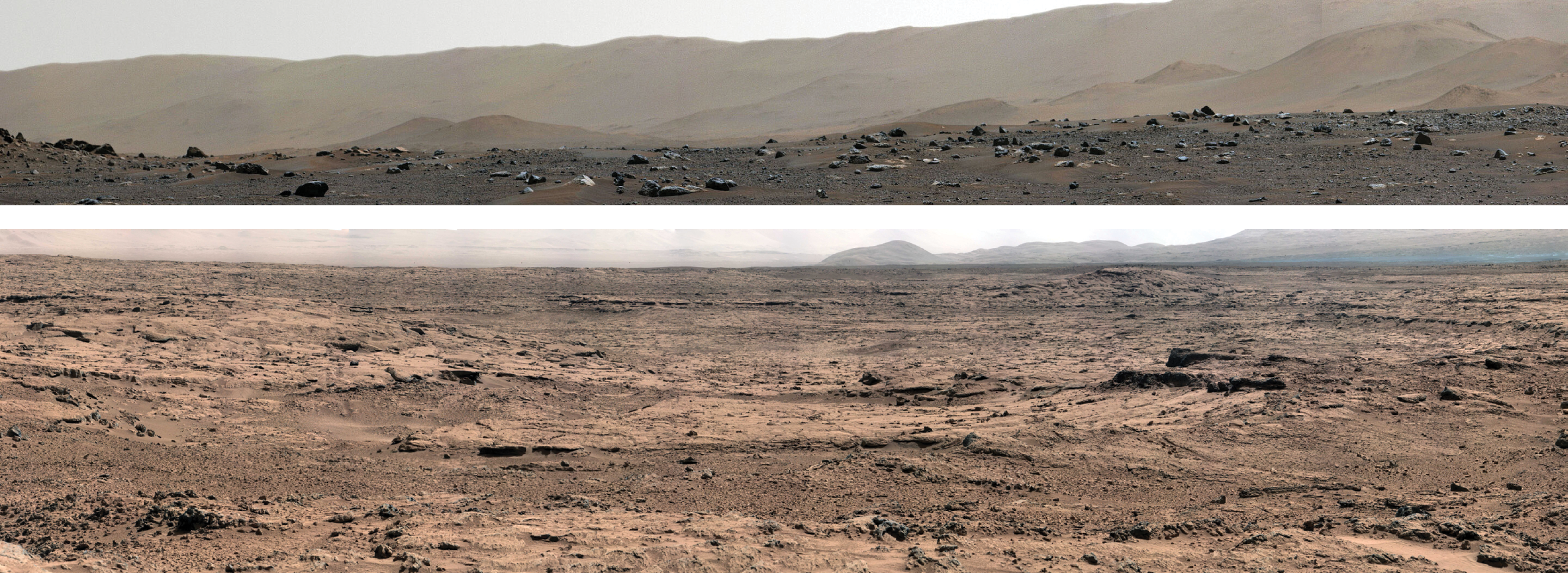
Martian soil is essentially analogous to the type found on Earth near iron-rich volcanoes, and it is probably drier than that found in the Sahara Desert. Although it is widely accepted that present-day Martian soil cannot support life, the search for past biosignatures, such as fossils, remains ongoing. Bringing Martian samples to Earth would be a groundbreaking step in that research, but it would be expensive and carries the danger of cross contamination. Moreover, that research has historically been complicated by the presence of structures in Martian soil that resemble fossils yet are not.
More than 95% of the Martian atmosphere is composed of carbon dioxide. With a surface pressure that’s 0.6% of Earth’s, Mars’s atmosphere is thin, primarily because of its weak gravity: Mars is approximately half the size of Earth, and its gravity is about 38% of ours. Because the escape velocity of air is determined by both a planet’s gravitational field and its radius, atmospheric species can more easily escape to space from Mars than from Earth.
Mars’s atmosphere extends about 250 km above the surface. It is divided into three distinct layers, which are determined by altitudinal changes in atmospheric temperature. 2 The first layer is the troposphere, which extends from the surface to 50 km above the Mars datum. Next comes the mesosphere, which ranges from 50 to 120 km above the surface, and above that is the thermosphere, which extends to about 250 km. Unlike Earth, Mars has no stratosphere: Because its lower atmosphere does not contain ozone, it does not absorb solar UV radiation like Earth’s and therefore lacks the temperature inversion that causes that layer to form.
Above the thermosphere is the exosphere, where the atmosphere becomes increasingly collisionless—the mean free path of the molecules becomes longer and the collisions between particles become less frequent. The highest portion of the thermosphere is often termed the exobase. Its altitude varies between 210 and 250 km, depending on the solar local time and season, as recently observed by the MAVEN (Mars Atmosphere and Volatile Evolution) spacecraft. 3
The Martian atmosphere is stably stratified, and buoyancy forces cause lighter air layers to float above the denser ones. Consequently, the air density drops off roughly exponentially with height. The stability of an air parcel can be disturbed by external influences. For example, surface heating initiates convection, which causes lighter, warmer air to rise upward and cool until it reaches its equilibrium level. That convective motion, or mixing, can occur only under unstable atmospheric conditions, in which lighter air temporarily lies below denser air.
Convection plays a central role in the transport of energy and momentum in planetary and even stellar atmospheres. It can generate atmospheric gravity waves with fast phase speeds. Gravity waves are natural buoyancy oscillations found in all stably stratified planetary atmospheres. By propagating over long distances and transferring energy and momentum from the lower regions of the atmosphere to higher altitudes, they significantly shape the temperature, circulation, and composition of the middle and upper atmosphere.
When atoms and molecules in a planetary atmosphere absorb solar energy, they can become excited, which means that the electrons are raised to a higher energy state than their ground state. If the absorbed energy exceeds the ionization energy of a given species, electrons can be ejected, resulting in the formation of a positively charged—or ionized—atom or molecule and a free electron. The region of ions and free electrons formed by the absorption of solar radiation is the ionosphere, a naturally occurring plasma environment that coexists with the neutral atmosphere.
Mars’s ionosphere begins approximately 90 km above the areoid and extends to a varying altitude of about 400–1200 km. That means it coincides with the upper mesosphere and thermosphere. Martian ions are produced by the ionization of carbon dioxide and oxygen atoms, whose lowest ionization energies are 13.78 eV and 13.61 eV, respectively. MAVEN observations, 4 however, demonstrate that molecular oxygen ions are a major species up to about 350 km. They are produced by two processes: charge transfer and atom–ion exchange between atomic oxygen and CO2+. Above that altitude, atomic oxygen ions become the most abundant ionospheric species. At lower altitudes, the ionosphere interacts significantly with the thermosphere, and the ions exchange energy and momentum with neutral particles and atmospheric waves. The topside ionosphere, on the other hand, is highly variable in density and structure. 5
Recent MAVEN observations demonstrate that the Martian ionosphere exhibits strong local time and seasonal variations with distinct hemispheric asymmetry. 6 It is also responsive to solar wind and solar activity. But ionospheric irregularities of various spatiotemporal scales are also often observed, which may be indicative of upward-propagating gravity waves.
Martian meteorology
Mars’s weather is characterized by features familiar to us on Earth, including atmospheric waves, winds, dust, clouds, and water vapor. Like terrestrial climate scientists do for Earth’s atmosphere, planetary scientists use numerical models to reveal how different Martian atmospheric layers and weather phenomena interact with each other and respond to external processes. Those models quantify energy, mass, and momentum transfer and are used to predict the future state of the Martian atmosphere on the basis of its current state. 1 , 7 But because we know far less about Mars than we do about Earth, models of the red planet’s atmosphere and weather are less robust than their counterparts on our planet: Present-day terrestrial weather models, for example, continuously assimilate global observational data at a high spatial resolution, but analogous models for Martian weather have not yet been developed. 8
Gravity waves contribute significantly to Martian weather. Sometimes called buoyancy waves, they are the most frequently observed type of wave on Mars and are produced by meteorological processes in the troposphere. 9 They owe their presence to the counteracting forces of gravity and buoyancy on vertical displacements of air. They are produced primarily in the troposphere by convection, nonlinear instabilities, and atmospheric flow over Martian surface topography. Because of the conservation of energy, gravity waves’ amplitudes increase as they propagate upward. In the mesosphere and thermosphere, the amplitudes become so large that the atmosphere cannot sustain the associated fluctuations. Like ocean waves approaching the shore, the waves can become unstable and ultimately break or saturate, and the carried energy momentum gets transferred to higher altitudes. For that reason, gravity waves play a crucial role in the thermal and dynamical structure of the entire Martian atmosphere system. 2 Because the resolution of Martian global atmospheric models is not sufficient to capture all gravity waves, mathematical parameterizations are used to account for their missing effects.
Water vapor is another important component of Martian meteorology. The climate in the lower atmosphere is greatly influenced by the amount and global distribution of water vapor. Water is a complex, radiatively active molecule that is essential to the formation of life, especially in its liquid state, and it could indicate the presence of climatological conditions like Earth’s. Although several astronomers in the 19th century claimed to have discovered water in the atmosphere of Mars, the first definitive evidence of water vapor on Mars came in 1963. 10 Despite its currently dry state, Mars has plenty of water, but it is mainly in the vapor and ice states, with the latter located in the polar caps and subsurface ice. Martian water-vapor concentration varies seasonally but hovers around 150 ppm.
Clouds and dust
Water is the main constituent of clouds, which are a vital component of terrestrial weather and life. Clouds consist of micron-scale droplets or ice crystals that are suspended in air and are numerous enough to be observed with the naked eye. They are formed by condensation of water vapor (or other gases) on nucleating hygroscopic particles, which can absorb water. On Earth, clouds are important in the hydrological cycle because they redistribute water to the surface in the form of precipitation. They are radiatively active, absorbing and reflecting high-frequency solar energy at various wavelengths.
Martian clouds are observable by orbiters, rovers, and telescopes (see figures
Figure 3.

Early images of Martian clouds. At left is the first image of clouds on Mars. Taken by the Mars Pathfinder lander in 1997, it depicts stratus water-ice clouds at an altitude of about 16 km. The “You are here” sign marks Earth’s position in the Martian sky at the time the image was taken. At right is an image of Mars captured by the Hubble Space Telescope in June 2001. Water-ice clouds exhibiting wavelike behavior are visible at high latitudes in the northern hemisphere. Seasonal dust activity can be seen near Hellas Planitia in the southern hemisphere at bottom right. (Left image courtesy of NASA/JPL/University of Arizona; right image, NASA/Hubble Heritage Team.)
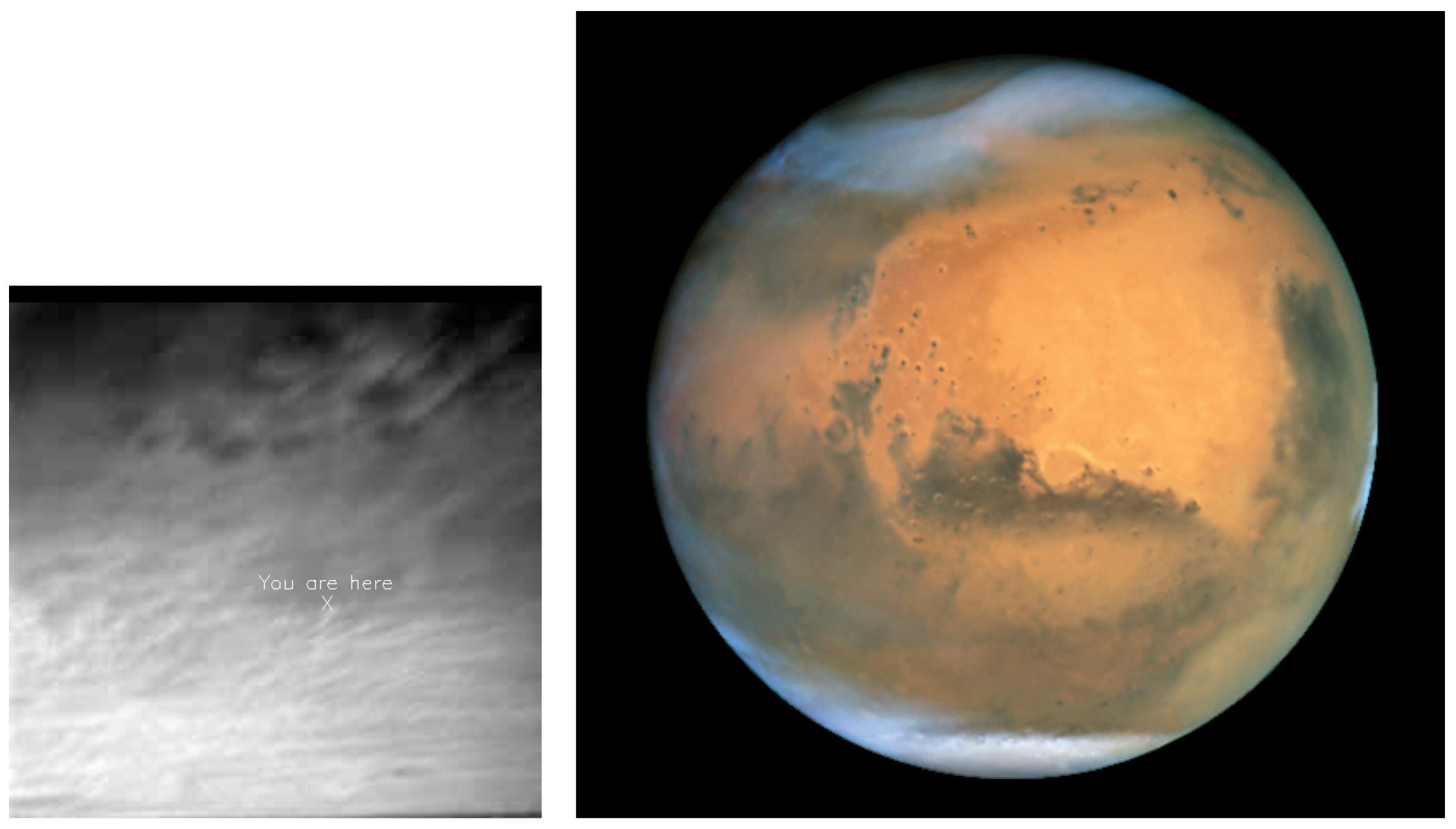
Figure 4.

Images taken by the Curiosity (top) and Perseverance (bottom) rovers in 2019 and 2023, respectively, capture cirrus-like cloud structures. (Top image courtesy of NASA/JPL-Caltech; bottom image, NASA/JPL-Caltech/Kevin M. Gill.)
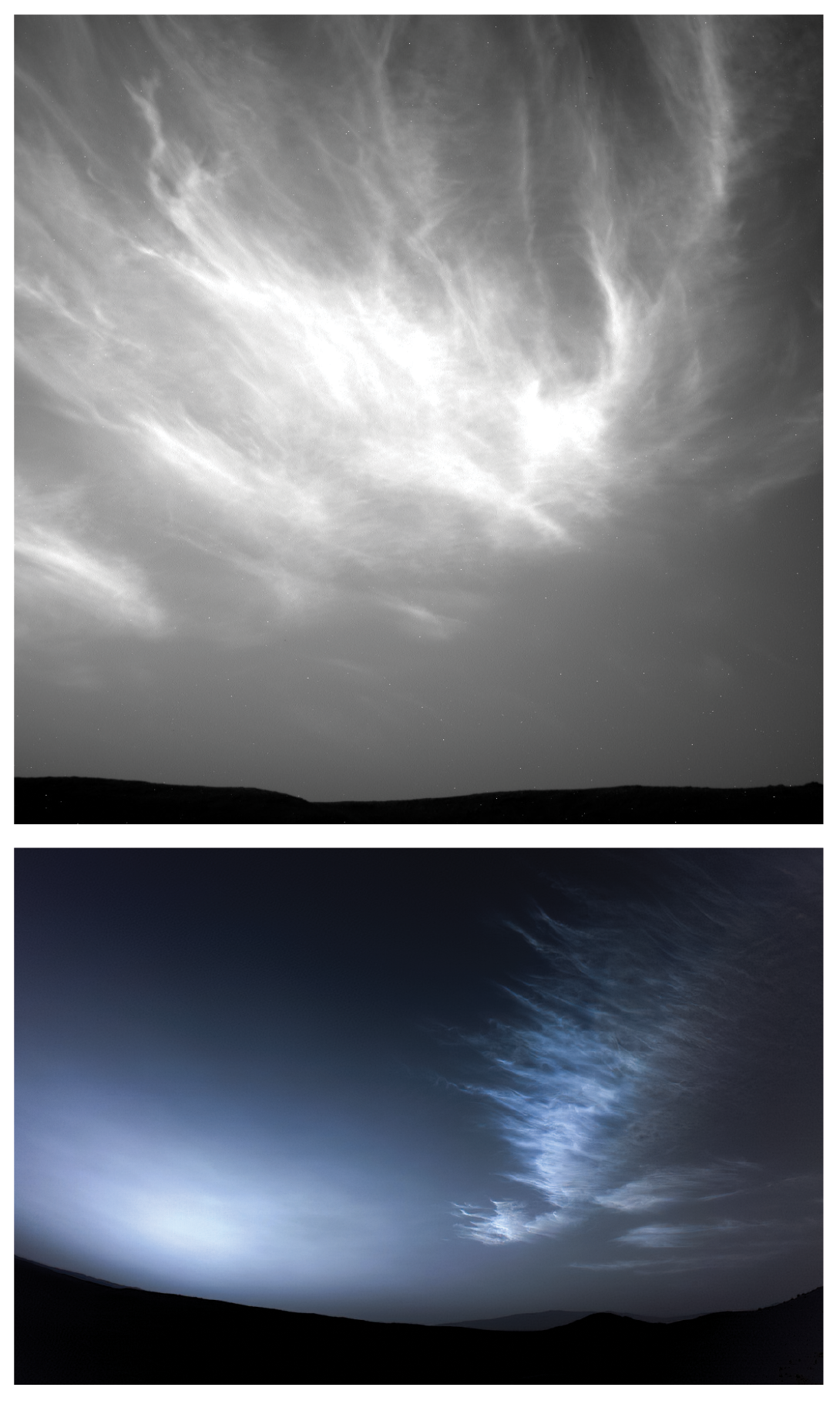
Mars has a CO2 cycle that consists of a seasonal global exchange of the gas between the troposphere and the polar ice caps. Although tropospheric temperatures are too warm for CO2 ice clouds to form, mesospheric temperatures are cold enough to allow for their emergence, especially at night. 11 In the low-pressure environment of the Martian mesosphere, lower temperatures and a higher degree of supersaturation are required for ice crystals to form. By acting as ice-nucleating particles, aerosols provide favorable conditions for the formation of cloud particles.
Martian high-altitude mesospheric clouds are somewhat similar to terrestrial high-latitude polar mesospheric clouds—also known as noctilucent clouds—in their formation altitude and wavy structure. But they also differ in significant ways: Martian clouds have larger ice-crystal sizes, occur across the entire planet, and are distributed over a wider range of altitudes. On Mars, dust storms often raise dust upward, which significantly increases the distribution of aerosols at high altitudes, and thus the storms can be an important factor in high-altitude ice-cloud formation and variability. Gravity waves and solar tides modulate the formation and distribution of mesospheric CO2 ice clouds by perturbing the background temperature and density. That process can lead to a decrease in local temperature below the CO2 frost point.
Mars is a dusty planet, and dust is an important atmospheric aerosol that possesses significant radiative properties. Dust can be easily raised and distributed globally, particularly during the perihelion season, when Mars’s southern hemisphere experiences summer and the atmospheric circulation intensifies. Martian dust clouds are essentially thunderstorm-like and can rapidly spread across the entire planet. Regional dust storms lasting for a few weeks occur every year; more powerful, long-lasting global major dust storms are rarer.
Understanding dust-storm evolution is essential to landing and communicating with spacecraft on the planet because dust accompanied by fast winds can significantly obstruct sensors and even lead to a temporary shutdown of orbiter and rover operations. In 1971, for example, Mariner 9 entered Martian orbit only to find the planet’s surface completely obscured by a planetwide dust storm. The Opportunity rover was permanently shut down in June 2018 by a global dust storm that lowered incoming solar radiation to its solar panels below survivable levels. (The opening
The absorption of solar energy by dust can significantly affect the energy balance of the atmosphere and amplify processes such as deep convection, which involves thermally driven turbulent mixing of the atmosphere from the surface to higher altitudes. The 2018 dust storm increased deep convective activity. It also transported water upward in the atmosphere, thus substantially increasing the water content in the middle atmosphere and causing a rise in the hygropause, the altitude where water vapor condenses into the liquid state and forms clouds. 12
Space weather and escape
Although Mars has strong localized crustal magnetic fields distributed primarily in the southern hemisphere, it lacks a global magnetic field. 13 For that reason, even though Mars is farther away from the Sun than Earth is, the effects of the solar wind and other space-weather phenomena are more pronounced. Our reference point for understanding space weather is Earth, where the solar wind’s interaction with the intrinsic magnetic field and increased particle precipitation into the atmosphere during magnetically active conditions lead to magnetic storms. During those storms, ionization rates increase, and the upper atmosphere is significantly heated because of the increased absorption of solar energy and ion–neutral frictional heating. Strong magnetic fields can confine charged-particle motion and inhibit the direct penetration of charged particles into lower-lying layers.
Other types of space weather, including solar flares and coronal mass ejections, produce intense radiation that affects Mars’s atmosphere and ionosphere. In September 2017, one of the strongest—or X-class—flares tripled the ionization radiation within a few tens of minutes, changed the ion density and composition, and increased the ionospheric plasma content. 14 During intense solar-heating events, the atmosphere responds by expanding and redistributing the absorbed heat.
Because atmospheric loss to space may have led to Mars’s currently dry and lifeless conditions, the effect of space weather on atmospheric escape is a central subject of research. The degree of escape is typically quantified by an escape flux. Essentially, particles with sufficient translational energy—that is, energy associated with uniform irrotational motion—can escape to space. Around the exobase, particle behavior can be approximated by a Maxwell–Boltzmann distribution. Particles in the high-velocity tail of the distribution that have outward-directed velocities exceeding the escape velocity are likely to be lost to space. Both thermal escape—also known as Jeans escape—and nonthermal escape mechanisms cause atmospheric loss on Mars.
Atmospheric escape can be influenced from above and below. Space-weather effects caused by solar flares, coronal mass ejections, and solar wind–ionosphere interactions can enhance atmospheric emissions, increase ionization and atmospheric temperature, and ultimately lead to a substantial increase in atomic hydrogen escape. 15 In the lower atmosphere, dust-storm-induced thermal changes and gravity-wave upward propagation can lead to enhanced thermal escape around the exobase. 16
The loss of atomic hydrogen from Mars’s upper atmosphere affects the planet’s water budget because water photolyzes in the thermosphere and produces hydrogen radicals. Because life on Earth started in water, that loss is relevant to the search for life on Mars, which focuses on water reservoirs under its surface and water vapor in its atmosphere. Mars is thought to have possessed sufficient water on its surface billions of years ago to provide more habitable conditions. But a chain of dynamical and radiative processes, including the thermal loss of hydrogen, appears to have led to the depletion of water reservoirs on Mars.
Living on Mars
Will humanity colonize Mars soon? A deeper understanding of the relationship between Martian meteorology, atmospheric waves, and space weather is a crucial step in planning a potential settlement on the red planet. But many other problems make future human exploration and settlements of Mars an extremely challenging and dangerous endeavor.
To begin with, we would need to get there safely, which would involve surviving nine months of space travel with limited room and resources in a rather unhealthy environment for the human body and mind. Astronauts would be dealing with significant technological, physiological, and psychological challenges. Such a long-range trip has not yet been attempted by humans, although astronauts routinely live for several months in the International Space Station in low Earth orbit.
As an alternative to directly flying to Mars, a base camp could be built on the Moon to serve as a training station for missions to Mars. That is what NASA’s Artemis program is attempting (see the article by Michael J. Neufeld, Physics Today, December 2023, page 40
Mars’s surface is hostile to human life. Because the red planet’s atmosphere lacks major chemical absorbers, harmful portions of the solar spectrum can penetrate directly to the surface. Furthermore, Mars’s lack of a global magnetic field means that charged particles, such as cosmic rays, can reach the surface far more easily than on Earth. Future human settlers would also be confronted with the planet’s harsh atmosphere and weather, including dust storms, high-speed winds, and extremely low temperatures. It is a technological mystery whether human suits and settlements can ever be designed to provide continuous protection from those conditions.
Some have suggested terraforming Mars or transforming it into a more habitable planet by means of global-scale environmental engineering. 17 But our current technology does not allow for geoengineering on the planetary scale. An alternative approach would be to adapt the human genome so that it can survive in Mars’s environment. But that rather drastic measure would require overcoming biochemical challenges; moreover, it is a subject of intense ethical discussion. A possible compromise might involve future human settlers living permanently in habitats that are technologically equipped to protect them from the Martian environment. 18 In the end, human exploration of the Martian surface will require a major paradigm shift in our perception of humanity’s place in the solar system and the universe.
References
1. A. S. Medvedev et al., J. Geophys. Res. Planets 118, 2234 (2013). https://doi.org/10.1002/2013JE004429
2. E. Yiğit, Nat. Geosci. 16, 123 (2023). https://doi.org/10.1038/s41561-022-01118-7
3. M. H. Fu et al., Earth Planet. Phys. 4, 1 (2020). https://doi.org/10.26464/epp2020010
4. M. Benna et al., Geophys. Res. Lett. 42, 8958 (2015). https://doi.org/10.1002/2015GL066146
5. E. Dubinin et al., J. Geophys. Res. Space Phys. 124, 9725 (2019). https://doi.org/10.1029/2019JA027077
6. H. Le et al., J. Geophys. Res. Planets 127, e2021JE007143 (2022). https://doi.org/10.1029/2021JE007143
7. S. W. Bougher et al., J. Geophys. Res. Planets 120, 311 (2015). https://doi.org/10.1002/2014JE004715
8. P. Rogberg et al., Q. J. R. Meteorol. Soc. 136, 1614 (2010). https://doi.org/10.1002/qj.677
9. E. Yiğit, A. S. Medvedev, P. Hartogh, Astrophys. J. 920, 69 (2021). https://doi.org/10.3847/1538-4357/ac15fc
10. H. Spinrad, G. Münch, L. D. Kaplan, Astrophys. J. 137, 1319 (1963). https://doi.org/10.1086/147613
11. R. T. Clancy, B. J. Sandor, Geophys. Res. Lett. 25, 489 (1998). https://doi.org/10.1029/98GL00114
12. N. G. Heavens, D. M. Kass, J. H. Shirley, J. Geophys. Res. Planets 124, 2863 (2019). https://doi.org/10.1029/2019JE006110
13. M. H. Acuña et al., Science 279, 1676 (1998). https://doi.org/10.1126/science.279.5357.1676
14. E. M. B. Thiemann et al., Geophys. Res. Lett. 45, 8005 (2018). https://doi.org/10.1029/2018GL077730
15. M. Mayyasi et al., Geophys. Res. Lett. 45, 8844 (2018). https://doi.org/10.1029/2018GL077727
16. E. Yiğit et al., Geophys. Res. Lett. 48, e2020GL092095 (2021). https://doi.org/10.1029/2020GL092095
17. C. P. McKay, O. B. Toon, J. F. Kasting, Nature 352, 489 (1991). https://doi.org/10.1038/352489a0
18. M. Balistreri, S. Umbrello, Nanoethics 17, 5 (2023). https://doi.org/10.1007/s11569-023-00440-7
More about the Authors
Erdal Yiğit is a professor of physics at George Mason University in Fairfax, Virginia. His research focuses on the global modeling and observation of internal-wave effects in planetary atmospheres.

